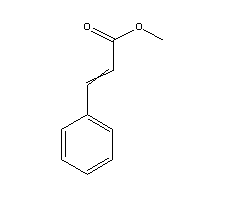methyl cinnamate
Inquiry
| Post Date: | Dec 18,2019 |
| Expiry Date: | Dec 17,2020 |
| Detailed Description: |
Cas No. :103-26-4
Usage:
In the international market, it is mainly used in essence, spices and sunscreen. China's GB-2760-2014 provides for the use of edible flavors. It is used in the fragrance industry as a deodorant. It is often used to blend oriental floral fragrances such as carnations, cherries, strawberries and grapes. It is used in soaps, detergents, flavors and pastries. Methyl cinnamate and ethyl cinnamate can be added to cigarette cut tobacco for use as a flavoring agent and a flavoring compensator. As an organic synthesis intermediate, it is mainly used in the pharmaceutical industry. The medicinal value of methyl cinnamate: methyl imidazole and methyl cinnamate are used as an intermediate linker to prepare methyl p-bromomethylcinnamate, which is the main raw material for the production of ozagrel. Methyl cinnamate has a positive effect on the inhibition of vitiligo. In whitening and sunscreen, the effect of methyl cinnamate is obvious. Methyl cinnamate (C6H5CHCHCOOCH3) is a white crystal with a melting point of 34 ° C. It is insoluble in water and soluble in ethanol and ether. Due to its fresh fruit flavor, it is often used in the perfume industry to formulate fruit flavors, oriental flavors and soap flavors. Such as high-grade flavor, has a wide range of uses in food, daily cosmetics, soap, etc. About the preparation of methyl cinnamate, using polyvinyl pyridine as a catalyst, so that cinnamic acid and thionyl chloride action into cinnamoyl chloride, and then Report on the preparation of methyl cinnamate by reaction with methanol. This method not only has low yield (yield 77%), many side reactions, complicated operation steps, corrosion equipment, and tail gas recovery problems, but also causes environmental pollution. The synthesis of methyl cinnamate by ethylene glycol and palladium chloride, polyvinyl chloride ferric chloride resin and ammonium ferric sulfate dodecahydrate as catalysts, but these methods are also not satisfactory. Solid superacid ZrO2/S2O2- The method of catalytic synthesis of methyl cinnamate has not been reported in the literature at home and abroad. The authors synthesized methyl cinnamate with cinnamic acid and methanol under the catalysis of solid superacid ZrO2/S2O2-8. The catalyst is cheap and easy to obtain and catalyze. High activity, Etching apparatus, recycled reuse. This method is simple, mild reaction conditions, environmental friendliness and high yields. Methyl cinnamate, also known as β-phenyl methacrylate, has a cocoa flavor and is mainly used in the daily chemical and food industries. It is a commonly used deodorant or food flavor, and is also an important organic synthetic raw material. At present, its synthesis methods include inorganic acid (such as hydrochloric acid, sulfuric acid) catalyzed esterification, organic acid catalyzed esterification, heterogeneous catalytic esterification and high pressure microwave synthesis. The inorganic acid catalyzed esterification method has many side reactions, long reaction time, low product yield, serious equipment corrosion, wastewater generated by post-treatment, etc. The reaction time of heterogeneous catalytic esterification method is long, and the product yield is not high (72%). ~87%); organic acid catalyzed esterification method has short reaction time and high product yield, but high cost; high-pressure microwave synthesis method can overcome the shortcomings of the first three methods, but it is difficult to realize industrial production. In the 1920s, the chemistry laboratory of Princeton University in the United States found that ultrasound has the effect of accelerating chemical reactions. In the mid-1980s, the application of ultrasonic in chemistry was rapidly developed. Ultrasound has been applied to oxidation and reduction reactions in organic chemistry. , addition reaction, polycondensation reaction, hydrolysis reaction, etc., almost involve various fields of organic chemistry, and ultrasonic chemistry is considered to be green chemistry. As a new form of energy, ultrasonic wave is used in organic chemical reactions, which not only makes many reactions that could not be carried out or difficult to carry out smoothly, but also is much better than traditional mixing as a convenient, rapid, effective and safe synthesis technology. , external heating method. |
| CAS Registry Number: | 103-26-4 |
| Synonyms: | ;2-Propenoic acid, 3-phenyl-, methyl ester;Methyl 3-phenyl propenoate; METHYL CINNAMATE;NATURAL METHYL CINNAMATE;methyl 3-phenylprop-2-enoate;(2E)-3-phenyloct-2-enal;(2E)-3-(2-methylphenyl)prop-2-enoate;methyl (2Z)-3-phenylprop-2-enoate;methyl (E)-3-phenylprop-2-enoate; |
| Molecular Formula: | C10H10O2 |
| Molecular Weight: | 162.1852 |
| Molecular Structure: | 
|
| Safety Description: | S22:; S24/25:; |
| Company: | Wuhan LANDMARK Industrial Co., Ltd [ China ] |
| Contact: | Halsey |
| Tel: | 18062529653 |
| Fax: | |
| Email: | Halsey.lmd@gmail.com |
-
Disclaimer statement:The information and data included above have been realized by the enterprises and compiled by the staff, and are subject to change without notice to you. The Chemnet makes no warranties or representations whatsoever regarding the facticity, accuracy and validity of such information and data. In order to ensure your interest, we suggest you chose the products posted by our gold suppliers or VIP members.


